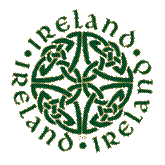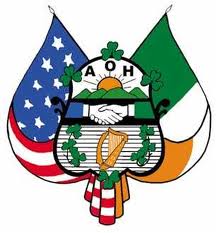 Through the centuries, Ireland has been known by many names. According to Foras Feasa ar Eireinn (the History of Ireland), written by Geoffrey Keating in 1629,the first names by which Ireland was known were Inis na Fidbadh (Inish naFveevah), meaning “The Isle of Woods”, and Crioch na fuinedach (Creeagh na Fwinnayagh), which translated “The Remote Country”. These names were given by early explorers. The first name associated with settlers was Inis Elga (Inish Alga) or “The Noble Island” by which it was known during the time of the FirBolg.
Through the centuries, Ireland has been known by many names. According to Foras Feasa ar Eireinn (the History of Ireland), written by Geoffrey Keating in 1629,the first names by which Ireland was known were Inis na Fidbadh (Inish naFveevah), meaning “The Isle of Woods”, and Crioch na fuinedach (Creeagh na Fwinnayagh), which translated “The Remote Country”. These names were given by early explorers. The first name associated with settlers was Inis Elga (Inish Alga) or “The Noble Island” by which it was known during the time of the FirBolg.
The next designation came from the people who displaced the Fir Bolg. They were the Tuatha deDanann or the people of the goddess Dana, and they called the island Inis Fail (Inish Fawl), after Lia Fail, the Stone of Fate which they brought with them to Ireland. It was the stone on which they elected their kings, for it was enchanted and could roar, but only under the rightful ruler of the land. It was last reported to have roared under Conchobar (Conor Mac Nessa), for when Christ was born, all the idols of the world were struck dumb.
 The ancient Greeks and Romans also had names for Ireland. They called it Ierna and Hibernia; the latter, being the oldest name by which it was known to the world at large, was the name adopted by the Ancient Order of Hibernians to illustrate the antiquity of their race. The next to name the island were a branch of the Celts (Gaels). They were descendants of the clan of Niul and his wife Scota, who had wandered south out of Scythia centuries before. A nomadic society, they migrated to Galatia (ref: St Pauls letters to the Galatians) in Greece, through Egypt, and up to the Iberian peninsula near present day Portugal (Porta Galli – port of the Gaels). While there, their great druid, Amergin, prophesied that the land of destiny foretold in their legends was just across the western ocean.
The ancient Greeks and Romans also had names for Ireland. They called it Ierna and Hibernia; the latter, being the oldest name by which it was known to the world at large, was the name adopted by the Ancient Order of Hibernians to illustrate the antiquity of their race. The next to name the island were a branch of the Celts (Gaels). They were descendants of the clan of Niul and his wife Scota, who had wandered south out of Scythia centuries before. A nomadic society, they migrated to Galatia (ref: St Pauls letters to the Galatians) in Greece, through Egypt, and up to the Iberian peninsula near present day Portugal (Porta Galli – port of the Gaels). While there, their great druid, Amergin, prophesied that the land of destiny foretold in their legends was just across the western ocean.
The Clan Chieftain, Milesius, ordered the journey, but died before it could be made. His wife, a warrior queen who was also named Scota, led the Gaels to Ireland, and it is either for her or for the matriarch of the clan that the people were called Scoti (the sons of Scota) by the Romans of the day. Later Roman writers even gave the island another of its names, Scotia, although it never stuck. However, the “Scoti” of Ireland who migrated to Alba caused the Romans to also refer to that land mass as Scoti Land, and this time the name did stick. Years later, the remnants of those Celtic people who fled English tyranny in Scotland to come to the new world brought the name with them to Nova Scotia (New Scotland).
 The Celts were responsible for three other names by which the country was known. When the Milesians first came to Ireland, the druid Amergin learned that there were three Kings of the Country, Mac Keact, MacCoill, and MacGreni, each of whom ruled in rotation. He sought out their three queens, and promised each that her name would be on the island forever if she would convince the De Danann to submit. Each promised to try, but failed; nevertheless, in their memory, Amergin promised that the country would everafter be called Fodla in song; Banba in poetry; and, since Eiru was the queen ofthe ruling King Mac Greni, hers would be the main name of the country forever. That name, given by the last of the ancient settlers, has lasted to the present day. Eire (the Gaelicized version of Eiru), in the Gaelic language conjugates: Eire(nom); Eireann (gen); and Erinn (abl); and although it is correct to write Eire go Braugh, rather than Eireann go Braugh, the latter (and its anglicized version Erin go Bra) has become accepted through colloquial usage.
The Celts were responsible for three other names by which the country was known. When the Milesians first came to Ireland, the druid Amergin learned that there were three Kings of the Country, Mac Keact, MacCoill, and MacGreni, each of whom ruled in rotation. He sought out their three queens, and promised each that her name would be on the island forever if she would convince the De Danann to submit. Each promised to try, but failed; nevertheless, in their memory, Amergin promised that the country would everafter be called Fodla in song; Banba in poetry; and, since Eiru was the queen ofthe ruling King Mac Greni, hers would be the main name of the country forever. That name, given by the last of the ancient settlers, has lasted to the present day. Eire (the Gaelicized version of Eiru), in the Gaelic language conjugates: Eire(nom); Eireann (gen); and Erinn (abl); and although it is correct to write Eire go Braugh, rather than Eireann go Braugh, the latter (and its anglicized version Erin go Bra) has become accepted through colloquial usage.
Another name also came from those Celtic invaders. When the sons of Milesius divided up the land, Heremon took the north, Eber took the south, and the northeast corner was given to the sons of their brother, Ir, who died in taking the land. He was the first of the Milesians to be buried in Irish soil and the modern English name of the country actually came from him, for the Northmen and Saxons whose first contact was with the tribe of Ir, came to call it the land of the tribe of Ir or Irlanda.
As with many modern nations, politics also provided designations such as the Irish Free State which came frm the Anglo-Irish Treaty of 1921; and the Republic of Ireland which was confirmed by the Republic of Ireland Act in 1948. Several other minor appellations are recorded in text such as Ogygia (the Ancient Isle) used by Plutocrat, and Muich Inis (the Isle of Mist or Fog) as it was called by the Milesians before they landed. There are also spelling variations of early names such as Juvernia according to Ptolmey, Juverna according to Solinus, Ierna according to Claudian, and even Irin as it is mentioned in the Argonautics, a Greek poem written in 500 BC. There were titles too, such as the Lamp of the West, the University of Europe, and The Isle of Saints and Scholars which were bestowed on the land in recognition of the scholastic achievements of her people.
Only an ancient and venerable nation could have warranted so many diverse names in her history, and the names by which she is known today still reflect that mystical past: Eire or Erin conjures up the magical Queen of the Tuatha de Danann; and Ireland reminds us of the first of the heroic Celts to give his life for the land.
But there are yet other names; not the names by which she is known today, nor the names she has been called since the dawn of time, but names of the heart; names by which she was known during the dark night of persecution; names given during the Penal times, when the bards of Eire were forbidden, under penalty of dungeon and death, to write in praise of their native land. They who could not conceal their passion for their land chose to cloak her identity with such metaphoric names such as Kathleen in Houlihan, the Proud Old Woman, the Old Woman of Beare, and Roisin Dubh, and these are perhaps Ireland’s proudest names.
*This article was taken from the Rhode Island AOH State Board website
